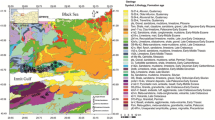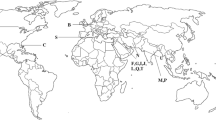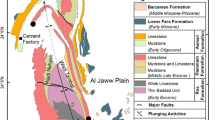Abstract
In the present research, engineering properties of some sedimentary rock samples were measured to assess the correlations between P wave velocity and physical, index, and mechanical properties. The physical properties include dry and saturated unit weights, porosity, and water absorption. The index properties contain Schmidt rebound hardness and slake-durability index. The mechanical properties include uniaxial compressive strength, point load index, Brazilian tensile strength, and block punch strength. For this purpose, a comprehensive laboratory testing program was conducted after collecting 15 various sedimentary rock samples of four rock types from northwestern parts of Damghan, northern Iran. In the following, empirical equations were developed by using regression analyses between P wave velocity and the measured properties. The obtained results showed that all of the properties have strongly correlated to P wave velocity. Hereof, the relationships between P wave velocity and porosity and water absorption were inverse linear. But, P wave velocity has direct linear correlations with the other properties. Prepared contour maps indicated that P wave velocity is more affected by porosity of the rocks. The curves with the 45° line (y = x) were extracted for evaluating the validity degree of concluded empirical equations which approved approximately close relationships between P wave velocity and the measured properties.















Similar content being viewed by others
References
Aligholi S, Lashkaripour GR, Ghafoori M (2016) Strength/brittleness classification of igneous intact rocks based on basic physical and dynamic properties. Rock Mech Rock Eng 50:45–65. https://doi.org/10.1007/s00603-016-1106-x
Altindag R (2012) Correlation between P-wave velocity and some mechanical properties for sedimentary rocks. J South Afr Inst Min Metall 112:229–237
Andrade PS, Saraiva AA (2010) Physical and mechanical characterization of phyllites and metagreywackes in Central Portugal. Bull Eng Geol Environ 69:207–214
ASTM (1990) Standard test method for slake durability of shales and similar weak rocks (D4644). In: Annual Book of ASTM Standards, vol 4.08, pp. 863–865
ASTM (1995) Standard test method for unconfined compressive strength of intact rock core specimens. In: ASTM standards on disc, vol 04.08; Designation, pp. D2938
ASTM (2001) Standard test method for determination of rock hardness by rebound hammer method. In: ASTM standards on disc, vol 04.09, pp. D5873-D5880
Aydin A (2014) Upgraded ISRM suggested method for determining sound velocity by ultrasonic pulse transmission technique. Rock Mech Rock Eng 47:255–259
Bell FG (2000) Engineering properties of soils and rocks. Blackwell Science Ltd, 4th ed. 482 p
Broch E, Franklin JA (1972) The point load strength test. Int J Rock Mech Min Sci 9:669–697
Cobanoglu I, Celik SB (2008) Estimation of uniaxial compressive strength from point load strength, Schmidt hardness and P-wave velocity. Bull Eng Geol Environ 67:491–498
Colombero C, Comina C, Umili G, Vinciguerra S (2016) Multiscale geophysical characterization of an unstable rock mass. Tectonophysics 675:275–289
Diamantis K, Gartzos E, Migiros G (2009) Study on uniaxial compressive strength point load strength index, dynamic and physical properties of serpentinites fromCentral Greece: test results and empirical relations. Eng Geol 108:199–207
Diamantis K, Bellas S, Migiros G, Gartzos E (2011) Correlating wave velocities with physical, mechanical properties and petrographic characteristics of peridotites from the Central Greece. Geotech Geol Eng 29(6):1049–1062
Fener M (2011) The effect of rock sample dimension on the P-wave velocity. J Nondestruct Eval 30:99–105
Fereidooni D (2016) Determination of the geotechnical characteristics of Hornfelsic rocks with a particular emphasis on the correlation between physical and mechanical properties. Rock Mech Rock Eng 49:2595–2608
Fereidooni D, Khanlari GR, Heidari M, Sepahi-Gero AA (2015) Assessment of engineering behavior of foliated rocks using some index tests, 24th international mining congress and exhibition of Turkey-IMCET'15 Antalya, Turkey, April 14-17, 2015, 617–629
Franklin J, Chandra R (1971) The slake-durability test. Int J Rock Mech Min Sci 9:325–341
Gamble JC (1971) Durability-Plasticity classification of shales and other argillaceous rocks. Ph.D. Thesis, University of Illinois, Urbana-Champaign, IL, p. 161
GSI (Geological Society of Iran) (1975) Geological quadrangle map of Iran, No. 6862, Scale 1:100000, Printed by Offset Press Inc. Tehran
IAEG (1979) Classification of rocks and soils for engineering geological mapping, part 1: rock and soil materials. Rep Comm Eng Geol Mapp Bull Int Assoc Eng Geol 19:364–371
Irfan TY, Dearman WR (1978) The engineering petrography of a weathered granite in Cornwall, England. Q J Eng Geol 11:233–244
ISRM (1981) Rock characterization testing and monitoring. In: Brown ET (ed). Pergamon press, Oxford, p 211
ISRM (2007) In: Ulusay R, Hudson JA (eds) The Blue Book: The Complete ISRM Suggested Methods for Rock Characterization, Testing and Monitoring, 1974–2006, Compilation Arranged by the ISRM Turkish National Group, Ankara, Turkey. Kazan Offset Press, Ankara
Kahraman S (2001) Evaluation of simple methods for assessing the uniaxial compressive strength of rock. Int J Rock Mech Min Sci 38:981–994
Kahraman S (2007) The correlations between the saturated and dry P-wave velocity of rocks. Ultrasonics 46:341–348
Kahraman S, Yeken T (2008) Determination of physical properties of carbonate rocks from P-wave velocity. Bull Eng Geol Environ 67:277–281
Karaman K, Kaya A, Kesimal A (2015) Effect of the specimen length on ultrasonic P-wave velocity in some volcanic rocks and limestones. J Afr Earth Sci 112:142–149
Kassab MA, Weller A (2015) Study on P-wave and S-wave velocity in dry and wet sandstones of Tushka region, Egypt. Egypt J Pet 24:1–11
Khandelwal M (2013) Correlating P-wave velocity with the physicomechanical properties of different rocks. Pure Appl Geophys 170:507–514
Khandelwal M, Singh TN (2009) Correlating static properties of coal measures rocks with p-wave velocity. Int J Coal Geol 79:55–60
Khanlari GR, Heidari M, Sepahi-Gero AA, Fereidooni D (2014a) Determination of geotechnical properties of anisotropic rocks using some index tests. Geotech Test J 37(2):1–13
Kilic A, Teymen A (2008) Determination of mechanical properties of rocks using simple methods. Bull Eng Geol Environ 67:237–244
Kurtulus C, Irmak TS, Sertcelik I (2010) Physical and mechanical properties of Gokceada: Imbroz (NE AegeanSea) island andesites. Bull Eng Geol Environ 69:321–324
Kurtulus C, Bozkurt A, Endes H (2011) Physical and mechanical properties of Serpentinized ultrabasic rocks in NW Turkey. Pure Appl Geophys 169(7):1205–1215
Kurtulus C, Sertcelik F, Sertcelik I (2015) Correlating physico-mechanical properties of intact rocks with P-wave velocity. Acta Geod Geophys 51:571–582. https://doi.org/10.1007/s40328-015-0145-1
Militzer H, Stoll R (1973) Einige Beitraige der Geophysik zur primadatenerfassung im Bergbau. Neue Bergbautechnik 3:21–25
Minaeian B, Ahangari K (2013) Estimation of uniaxial compressive strength based on P-wave and Schmidt hammer rebound using statistical method. Arab J Geosci 6:1925–1931
Sarkar K, Tiwary A, Singh TN (2010) Estimation of strength parameters of rock using artificial neural networks. Bull Eng Geol Environ 69:599–606
Sharma PK, Singh TN (2008) A correlation between P-wave velocity, impact strength index, slake durability index and uniaxial compressive strength. Bull Eng Geol Environ 67:17–22
Singh R, Vishal V, Singh TN, Ranjith PG (2012a) A comparative study of generalized regression neural network approach and adaptive neurofuzzy inference systems for prediction of unconfined compressive strength of rocks. Neural Comput Appl 23(2):499–506
Singh R, Vishal V, Singh TN (2012b) Soft computing method for assessment of compressional wave velocity. Sci Iran Trans Civil Eng 19(4):1018–1024
Sousa LMO, Del Rio LMS, Calleja L, ArgandonaVGR D, Rey A (2005) Influence of microfractures and porosity on the physicomechanical properties and weathering of ornamental granites. Eng Geol 77:153–168
Starzec P (1999) Dynamic elastic properties of crystalline rocks from south-West Sweden. Int J Rock Mech Min Sci 36:265–272
Torok A, Vasarhelyi B (2010) The influence of fabric and water content on selected rock mechanical parameters of travertine, examples from Hungary. Eng Geol 115:237–245
Turgrul A, Zarif IH (1999) Correlation of mineralogical and textural characteristics with engineering properties of selected granitic rocks from Turkey. Eng Geol 51:303–317
Ulusay R, Gokceoglu C, Sulukcu S (2001) Draft ISRM suggested method for determining block punch strength index (BPI). Int J Rock Mech Min Sci 38(8):1113–1119
Vasconcelos G, Lourenço PB, Alves CAS, Pamplona J (2008) Ultrasonic evaluation of the physical and mechanical properties of granites. Ultrasonics 48(5):453–466
Verma AK, Singh TN (2013) A neuro-fuzzy approach for prediction of longitudinal wave velocity. Neural Comput Appl 22(7–9):1685–1693
Yagiz S (2010) Correlation between slake durability and rock properties for some carbonate rocks. Bull Engineering Geology Environ 70(3):377–383
Yagiz S (2011a) Correlation between slake durability and rock properties for some carbonate rocks. Bull Eng Geol Environ 70:377–383
Yagiz S (2011b) P-wave velocity test for assessment of geotechnical properties of some rock materials. Bull Mater Sci 34(4):947–953
Yasar E, Erdogan Y (2004) Correlating sound velocity with the density, compressive strength and Young’s modulus of carbonate rocks. Int J Rock Mech Mining Sci 41:871–875
Author information
Authors and Affiliations
Corresponding author
Rights and permissions
About this article
Cite this article
Khajevand, R., Fereidooni, D. Assessing the empirical correlations between engineering properties and P wave velocity of some sedimentary rock samples from Damghan, northern Iran. Arab J Geosci 11, 528 (2018). https://doi.org/10.1007/s12517-018-3810-1
Received:
Accepted:
Published:
DOI: https://doi.org/10.1007/s12517-018-3810-1




